GSNadmin
Staff member
Tackling this particular aspect of WW I warbirds can be both challenging and rewarding. It’s really not di cult to do, once you understand the system and have relatively good organizational skills and a healthy dose of patience. Let’s start with some history. Before the advent of camouflage, all German aircraft were finished using clear dope over linen, resulting in a buff or off white color. Camouflage was introduced during 1916, and these early schemes had large organic blotches of either green or reddish brown, or mauve and olive (Albatros D IIs are a good example). Undersurfaces were usually a pale sky blue, however, natural doped linen was also used. To save on weight due to multiple coats of dope and paint, pre-printed camouflage fabric was introduced. The patterns were polygons of slightly different sizes in many different colors — what has come to be known as “lozenge camouflage.” In a directive dated April 12, 1917, a mandate stated that all new aircraft would be covered with printed lozenge camouflage. The change to this new color scheme was gradual, as aircraft with old paint schemes were left as is. The two basic styles of lozenge camo were “Knowlton (Quebec)” and “Canberra (Australia)”— these names refer to the regions where samples were studied and recorded after the war. If you are building a model that predates April of 1917, you probably won’t have to worry about replicating lozenge camouflage. However, if you like late model Albatros DVas or Fokker D VIIs, you may have to bite the bullet, although there were exceptions that omitted this scheme.
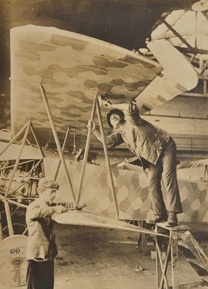
This vintage photograph shows workers examining a lozenge-covered Fokker D.VII.
TEMPLATES
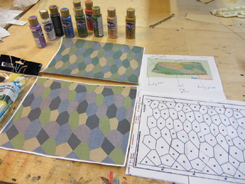
Several examples of lozenge camouflage found online and printed out using a home inkjet printer. Paint from A.C. Moore is near the top as is a printout of an image of an actual piece of lozenge camo in the permanent collection of the RAF Museum.
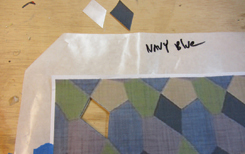
Tape down your frisket paper. Next tape down your lozenge pattern over it and mark which color you are cutting out in the margin. In this image I’m doing navy blue.
The first thing you’ll need to do is obtain a decent pattern for your lozenge camo. There are many fine examples online if you simply do an online search. You can then download and print these templates. Alternately, you can print a full-color version and use this as a template. You’ll want to get the scale of the lozenges correct and the way I usually work is to pick a point on the aircraft, say the side of the fuselage of a D VII right below the cockpit. Next, you simply count the number of lozenges from bottom up to give you the correct scale. For example, if the distance between the cockpit coaming and bottom of fuselage is 5 inches and six lozenges cover that distance in the full-size plane, you know you need six lozenges in a 5-inch span. You’ll then want to take your downloaded pattern and cut and paste to a Word document where you can adjust the size. Once you have the size you want, you can print out as many sheets as you want (I found I could get five templates out of two printouts). Next cut a piece of frisket paper for each color a little bit bigger than 8.5 × 11. Write the color in the margin. Tape the frisket paper and printout down using blue painter’s tape. Using a hobby knife, carefully cut out all the lozenges of the color marked on your sheet. Repeat with each different color taking care to maintain structural integrity of your printout. Make sure you have enough remaining lozenges so that the printout doesn’t fall apart! One way to ensure this is to cut the leg of the polygon that is adjacent to an already removed section first. This way, if you end up cutting loose an area, you do so with the final cut of the polygon. The beauty of making a set of templates is that you can use them on both the top and bottom wings, simply substituting different colors for the bottoms.
PAINT COLORS
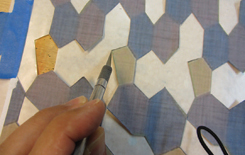
If a lozenge is helping hold the pattern together, start by cutting the free sides first. Then cut the sides that are attached to the rest of the pattern.
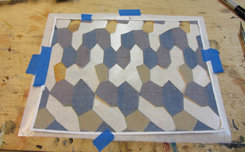
The khaki lozenges are nearly half-finished. As you progress, the pattern will get increasingly fragile, so be careful. I was able to get three different colors out of one pattern.
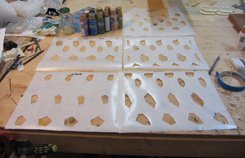
The finished set of masks for a five-color lozenge pattern.
Opinions vary regarding the authentic coloring of the lozenges. There have been studies on original samples by the Smithsonian and other museums. The result is a fairly accurate facsimile of the original colors, many of which are available online. However, you can personalize the colors to suite your taste and perhaps more importantly, to allow the bottom of the wings to be clearly different from the tops so that you don’t lose orientation while flying. You can experiment a bit to get a cache of colors that you like and that work well together.
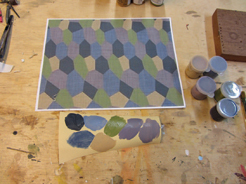
Mix up a test set of colors on a scrap of covering material until satisfied with your color choices. Have some fun with this!
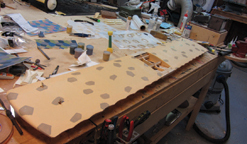
Beginning with the lightest color first (khaki), the tops of the bottom wings of a Fokker D-VII have been started.
I chose readily available acrylic paints from either Michael’s or A.C. Moore. These colors approximated the lozenge colors and can be intermixed to achieve the desired value and hue. They also adhere well to Solartex and various other covering films, dry flat, and are inexpensive. I also picked up some empty containers to hold my custom mixed colors.
Some of the available colors are a bit bright for my taste, so some mixing was needed. A quick lesson in color theory: if you want to dull a given color, simply add its complementary color. The complement of red is green, yellow is purple, and orange is blue. Using this simple formula will allow you to dull down stock colors to your liking. Adding white or black will lighten and darken a color, so you should be able to closely approximate a given color. Make up some test swatches on scrap covering until you achieve the desired color and value. Now, as if that’s not complicated enough, to make the five colors seem to work together you can add a little of a neighboring color to a given color (e.g. a little olive to the purple, a little khaki to the dark blue, etc.). Only a little is needed and will result in a more harmonious grouping of colors. Remember, choose colors that you like! If you think a purple is too bright or not bright enough, do what you want! There are so few authentic examples of actual lozenge camo available that you could get away with a lot of variety, within reason! Moreover, since these colors were printed on the fabric they faded a bit in sunlight and various weather conditions –– one more factor to consider! The colors I used were as follows: khaki, medium cornflower blue, dull olive, mauve, and a dark greyish navy. For the bottoms of the wings and fuselage I used: dusty rose, light ochre, light mauve, light greyish olive, and light cornflower blue. Remember, you’ll want the bottom to be markedly different from the top so that you don’t lose orientation of your plane when in the air!
PAINTING
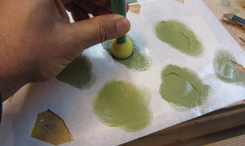
You can use a sponge applicator to apply the paint to the masks, however it may stretch the covering material and tends to yield a rather thick coat of paint. Remember keep your paint thin as it adds weight!
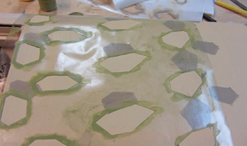
You can see how easy it is to line up the subsequent masks after the first lozenges have been painted.
OK, so you have your templates and you have your colors: now it is time to paint! Before starting on your airplane make a sample on a scrap of covering. This way you can see how your colors work or don’t work together. After I finished by sample, I adjusted the colors to get a combination that I found pleasing. Choose any easy surface to start with, like a top or bottom wing. If it’s a top wing start in the center and work your way out on either side. If it’s a bottom wing you can start at the tip or the root. On the full-size planes, the wings were covered in strips (fore and aft or perpendicular to the leading edge) with the longitudinal axis of the lozenge running lengthwise down the wing. The actual bolts of printed fabric were approximately 50 and 54 inches wide. Therefore, you’ll want to stagger the lozenge on the next (adjacent) swath to give it an organic feel. Make an extra printout of the finished scheme for reference. You can use an airbrush (which is quickest), but for the benefit of readers who don’t have one, I’ll do it using a brush. You can also use stenciling sponges but this may stretch your covering a bit.
Carefully peel the backing off the frisket paper. It’s a good idea to stick it to your T-shirt or some other cotton surface to dull down the adhesive a bit; you don’t want to have to struggle to pull off the masks. Now carefully line up the first mask and lightly tamp it down around the edge of each lozenge opening using your fingertip. Start with the lightest color, in this case the khaki. You always want to work lightest to darkest as dark colors will readily cover lighter ones; the reverse is seldom true. Using a 1/2-inch brush, apply a light coat of paint to each lozenge opening taking care to brush the paint away from the mask edge; this way to don’t force paint under the mask. Let dry and repeat. I needed two coats to get decent coverage. Keep those coats thin as paint adds weight! You may want to allow some of the Solartex to show through to add a worn or weathered effect.
After the khaki is dry, proceed to the olive color. Referring to the print-out, line up the green lozenges adjacent to the khaki ones where applicable. In some cases the point of the polygon will simply touch the point of another polygon. Carefully tamp down as before and apply your olive paint. You’ll repeat this process with the mauve and the cornflower blue ending up with the dark blue last. It’ll get easier as you go as it will be increasingly obvious where the next set of lozenges will go. Don’t be alarmed if all your lozenges don’t line up perfectly: you can touch them up after you’re finished. Repeat this process on all surfaces that require the dark lozenge color scheme. Repeat the process for the bottoms of the wings using the di erent set of colors mentioned earlier. Ultimately, I made a separate set of masks for the wing bottoms and I chose a four-color scheme as I simply liked the color combinations. If this process seems too daunting for your abilities, then thankfully there are some commercial coverings available (see sidebar).
Commercial Covering
There are three lozenge coverings available on the market: Arizona Model Crafters makes it in 1/12 on up; Balsa USA makes it in light and dark for 1/4- and 1/8-scale aircraft; and Glenn Torrance specializes in 1/4-, 1/8-, and larger scale models (he prints his on actual linen)! The advantage with these products is that you don’t have to paint and can simply cover your model with the product. The downside is the cost, and you’ll have to follow the application instructions carefully. So the following is an overview of the highlights of each product and a quick application guide.
Balsa USA’s Lozengetex
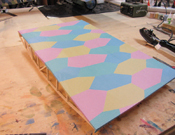
This 1/4- and 1/8-scale covering only comes in light and dark options, which are in strident contrast to each other. You won’t have any difficulty telling one surface from another in the air. If you’ve ever used Solartex, you won’t have any trouble applying Lozengetex as it handles in a very similar manner. It is resistant to glow, gas and diesel fuels. Even still, Balsa USA recommends coating the finishing airframe (after decals) with an oil-based polyurethane spray such as Minwax. Iron temperatures are as follows: for bonding covering to airframe: 100 to 120 degrees C; for shrinking: 130 to 150 degrees C. To see if the claims met the reality I prepared a sample Fokker D-VII wing panel from scrap balsa. I applied the covering and — voila! — the results were as advertised. You’ll want to use a sock on your iron to avoid scuffing the colors but other than that, it handles just like regular Solartex. balsausa.com
Arizona Model Aircrafters Lozenge Camo
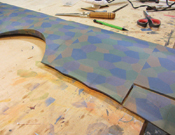
This company offers Lozenge camo in four and five colors as well as a night-fighter scheme. If you still can’t find what you’re looking for, they’ll be happy to customize any of their patterns with colors you choose. They’ll also enlarge or reduce the patterns to fit any size model. For example, I had a 50-inch-span Albatros DVa wing in the racks for which they were able to generate a custom size lozenge camo for that particular wing. The printed covering is translucent, so for optimal results it is recommended that you paint your airframe a light gray or white to make the airframe less apparent through the covering. I chose to paint my wing frame gray-green on top, and a medium brown on the bottom, which resulted in the frames being nearly invisible when the covering was applied. Next, simply iron it on as you would any heat-activated covering. Two swaths of rib tape material are included with the covering that you can cut into strips and apply over the wings. If you are using nitro power, it is also recommended that you spray a clear coating of Butyrate dope over the finished covering in light coats to prevent bleeding or running of the printed pattern. arizonamodels.com
Glenn Torrance Models Linen Covering
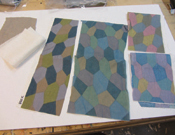
Glenn Torrance offers coverings for 1/4- and 1/8-scale aircraft that’s actually printed on linen just like the original aircraft! They start with raw linen, then bleach it, then screen the colors on. Being that it is actual linen, you’ll also have to apply and shrink it differently from the heat-activated coverings. First, the fabric is adhered to the airframe using fabric glue or stitches. Next, a couple of coats of nitrate dope are applied to fill the weave of the fabric. Finally, the fabric is shrunk drum-tight using multiple coats of Butyrate dope, just like on the full-size plane! Since it is fabric you can also stitch/sew together panels as in the full-size and even lace the bottom of your Fokker fuselage if you want. flygtm.com
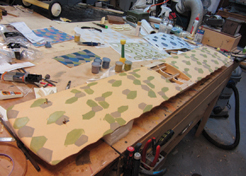
The olive and khaki colors have been applied. Don’t worry if your alignment isn’t perfect; you can always touch it up later. Just be sure to mix enough paint to do your entire plane plus extra for touch-up.
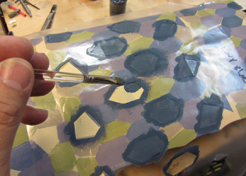
The last set of lozenges! Be sure to brush away from the edges of the mask to prevent bleeding.
CONCLUSION
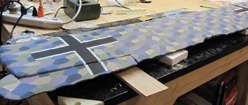
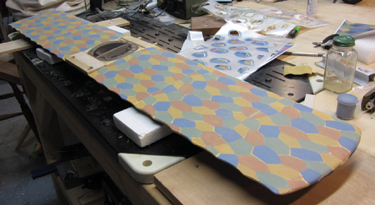
The finished top wing and bottom of the bottom wing. Notice how the two color schemes are markedly different — an important feature to maintain orientation when flying.
Any serious WW I enthusiast ought to try hand-painted lozenges at least once. It gets easier with practice and actually becomes a little addictive and fun! The touch up can be time-consuming, so align your templates carefully. After covering over a completely light-colored airframe, the one thing I would do differently next time would be to cover anything requiring the dark lozenge camo in a dark Solartex — olive drab or dark blue would be perfect as you may be able to use the olive or blue of the covering as one of the lozenges. It took about three or four busy days to cover an entire 1/6-scale model of a Fokker D VII. It’ll be less if you are covering a plane that only has partial lozenge covering such as a DVa or some of the Dr 1s; there are a lot of D-VIIs that also have only partial lozenge covering. The cost of materials is negligible, but be prepared to spend some time with it. Also, you have the advantage of getting the exact colors you want as products vary in color as does opinions as to the right colors for this type of camouflage. Careful review of primary source materials (such as actual planes or actual lozenge camo sample fabric from actual aircraft) will point you in the right direction.
If you simply don’t want to bother with painting, then simply be prepared to budget in some extra money for a given project to buy whichever commercial covering you decide to use. As discussed, these all have different application methods, and some only cater to large-scale aircraft. All the coverings discussed in this article worked well and as advertised, and I found them a welcome break after hand-painting my lozenges! Finally, this is a fascinating aspect of WW I aircraft and done well really adds a tremendous amount of interest to a given aircraft. A final consideration would be to be sure and add some bright accents to your airplane as the lozenge camouflage will do its job in low-light conditions or against a backdrop of trees. Making sure there is a good amount of difference between tops and bottoms of wings is a good start, but also consider using bright-colored cowls, wheel hubs, or tail feathers to ensure good orientation when you are on your next Dawn Patrol!
BY MARK WILKINS
Model Airplane News - The #1 resource for RC plane and helicopter enthusiasts featuring news, videos, product releases and tech tips.
Continue reading...

This vintage photograph shows workers examining a lozenge-covered Fokker D.VII.
TEMPLATES

Several examples of lozenge camouflage found online and printed out using a home inkjet printer. Paint from A.C. Moore is near the top as is a printout of an image of an actual piece of lozenge camo in the permanent collection of the RAF Museum.

Tape down your frisket paper. Next tape down your lozenge pattern over it and mark which color you are cutting out in the margin. In this image I’m doing navy blue.
The first thing you’ll need to do is obtain a decent pattern for your lozenge camo. There are many fine examples online if you simply do an online search. You can then download and print these templates. Alternately, you can print a full-color version and use this as a template. You’ll want to get the scale of the lozenges correct and the way I usually work is to pick a point on the aircraft, say the side of the fuselage of a D VII right below the cockpit. Next, you simply count the number of lozenges from bottom up to give you the correct scale. For example, if the distance between the cockpit coaming and bottom of fuselage is 5 inches and six lozenges cover that distance in the full-size plane, you know you need six lozenges in a 5-inch span. You’ll then want to take your downloaded pattern and cut and paste to a Word document where you can adjust the size. Once you have the size you want, you can print out as many sheets as you want (I found I could get five templates out of two printouts). Next cut a piece of frisket paper for each color a little bit bigger than 8.5 × 11. Write the color in the margin. Tape the frisket paper and printout down using blue painter’s tape. Using a hobby knife, carefully cut out all the lozenges of the color marked on your sheet. Repeat with each different color taking care to maintain structural integrity of your printout. Make sure you have enough remaining lozenges so that the printout doesn’t fall apart! One way to ensure this is to cut the leg of the polygon that is adjacent to an already removed section first. This way, if you end up cutting loose an area, you do so with the final cut of the polygon. The beauty of making a set of templates is that you can use them on both the top and bottom wings, simply substituting different colors for the bottoms.
PAINT COLORS

If a lozenge is helping hold the pattern together, start by cutting the free sides first. Then cut the sides that are attached to the rest of the pattern.

The khaki lozenges are nearly half-finished. As you progress, the pattern will get increasingly fragile, so be careful. I was able to get three different colors out of one pattern.

The finished set of masks for a five-color lozenge pattern.
Opinions vary regarding the authentic coloring of the lozenges. There have been studies on original samples by the Smithsonian and other museums. The result is a fairly accurate facsimile of the original colors, many of which are available online. However, you can personalize the colors to suite your taste and perhaps more importantly, to allow the bottom of the wings to be clearly different from the tops so that you don’t lose orientation while flying. You can experiment a bit to get a cache of colors that you like and that work well together.

Mix up a test set of colors on a scrap of covering material until satisfied with your color choices. Have some fun with this!

Beginning with the lightest color first (khaki), the tops of the bottom wings of a Fokker D-VII have been started.
I chose readily available acrylic paints from either Michael’s or A.C. Moore. These colors approximated the lozenge colors and can be intermixed to achieve the desired value and hue. They also adhere well to Solartex and various other covering films, dry flat, and are inexpensive. I also picked up some empty containers to hold my custom mixed colors.
Some of the available colors are a bit bright for my taste, so some mixing was needed. A quick lesson in color theory: if you want to dull a given color, simply add its complementary color. The complement of red is green, yellow is purple, and orange is blue. Using this simple formula will allow you to dull down stock colors to your liking. Adding white or black will lighten and darken a color, so you should be able to closely approximate a given color. Make up some test swatches on scrap covering until you achieve the desired color and value. Now, as if that’s not complicated enough, to make the five colors seem to work together you can add a little of a neighboring color to a given color (e.g. a little olive to the purple, a little khaki to the dark blue, etc.). Only a little is needed and will result in a more harmonious grouping of colors. Remember, choose colors that you like! If you think a purple is too bright or not bright enough, do what you want! There are so few authentic examples of actual lozenge camo available that you could get away with a lot of variety, within reason! Moreover, since these colors were printed on the fabric they faded a bit in sunlight and various weather conditions –– one more factor to consider! The colors I used were as follows: khaki, medium cornflower blue, dull olive, mauve, and a dark greyish navy. For the bottoms of the wings and fuselage I used: dusty rose, light ochre, light mauve, light greyish olive, and light cornflower blue. Remember, you’ll want the bottom to be markedly different from the top so that you don’t lose orientation of your plane when in the air!
PAINTING

You can use a sponge applicator to apply the paint to the masks, however it may stretch the covering material and tends to yield a rather thick coat of paint. Remember keep your paint thin as it adds weight!

You can see how easy it is to line up the subsequent masks after the first lozenges have been painted.
OK, so you have your templates and you have your colors: now it is time to paint! Before starting on your airplane make a sample on a scrap of covering. This way you can see how your colors work or don’t work together. After I finished by sample, I adjusted the colors to get a combination that I found pleasing. Choose any easy surface to start with, like a top or bottom wing. If it’s a top wing start in the center and work your way out on either side. If it’s a bottom wing you can start at the tip or the root. On the full-size planes, the wings were covered in strips (fore and aft or perpendicular to the leading edge) with the longitudinal axis of the lozenge running lengthwise down the wing. The actual bolts of printed fabric were approximately 50 and 54 inches wide. Therefore, you’ll want to stagger the lozenge on the next (adjacent) swath to give it an organic feel. Make an extra printout of the finished scheme for reference. You can use an airbrush (which is quickest), but for the benefit of readers who don’t have one, I’ll do it using a brush. You can also use stenciling sponges but this may stretch your covering a bit.
Carefully peel the backing off the frisket paper. It’s a good idea to stick it to your T-shirt or some other cotton surface to dull down the adhesive a bit; you don’t want to have to struggle to pull off the masks. Now carefully line up the first mask and lightly tamp it down around the edge of each lozenge opening using your fingertip. Start with the lightest color, in this case the khaki. You always want to work lightest to darkest as dark colors will readily cover lighter ones; the reverse is seldom true. Using a 1/2-inch brush, apply a light coat of paint to each lozenge opening taking care to brush the paint away from the mask edge; this way to don’t force paint under the mask. Let dry and repeat. I needed two coats to get decent coverage. Keep those coats thin as paint adds weight! You may want to allow some of the Solartex to show through to add a worn or weathered effect.
After the khaki is dry, proceed to the olive color. Referring to the print-out, line up the green lozenges adjacent to the khaki ones where applicable. In some cases the point of the polygon will simply touch the point of another polygon. Carefully tamp down as before and apply your olive paint. You’ll repeat this process with the mauve and the cornflower blue ending up with the dark blue last. It’ll get easier as you go as it will be increasingly obvious where the next set of lozenges will go. Don’t be alarmed if all your lozenges don’t line up perfectly: you can touch them up after you’re finished. Repeat this process on all surfaces that require the dark lozenge color scheme. Repeat the process for the bottoms of the wings using the di erent set of colors mentioned earlier. Ultimately, I made a separate set of masks for the wing bottoms and I chose a four-color scheme as I simply liked the color combinations. If this process seems too daunting for your abilities, then thankfully there are some commercial coverings available (see sidebar).
Commercial Covering
There are three lozenge coverings available on the market: Arizona Model Crafters makes it in 1/12 on up; Balsa USA makes it in light and dark for 1/4- and 1/8-scale aircraft; and Glenn Torrance specializes in 1/4-, 1/8-, and larger scale models (he prints his on actual linen)! The advantage with these products is that you don’t have to paint and can simply cover your model with the product. The downside is the cost, and you’ll have to follow the application instructions carefully. So the following is an overview of the highlights of each product and a quick application guide.
Balsa USA’s Lozengetex

This 1/4- and 1/8-scale covering only comes in light and dark options, which are in strident contrast to each other. You won’t have any difficulty telling one surface from another in the air. If you’ve ever used Solartex, you won’t have any trouble applying Lozengetex as it handles in a very similar manner. It is resistant to glow, gas and diesel fuels. Even still, Balsa USA recommends coating the finishing airframe (after decals) with an oil-based polyurethane spray such as Minwax. Iron temperatures are as follows: for bonding covering to airframe: 100 to 120 degrees C; for shrinking: 130 to 150 degrees C. To see if the claims met the reality I prepared a sample Fokker D-VII wing panel from scrap balsa. I applied the covering and — voila! — the results were as advertised. You’ll want to use a sock on your iron to avoid scuffing the colors but other than that, it handles just like regular Solartex. balsausa.com
Arizona Model Aircrafters Lozenge Camo

This company offers Lozenge camo in four and five colors as well as a night-fighter scheme. If you still can’t find what you’re looking for, they’ll be happy to customize any of their patterns with colors you choose. They’ll also enlarge or reduce the patterns to fit any size model. For example, I had a 50-inch-span Albatros DVa wing in the racks for which they were able to generate a custom size lozenge camo for that particular wing. The printed covering is translucent, so for optimal results it is recommended that you paint your airframe a light gray or white to make the airframe less apparent through the covering. I chose to paint my wing frame gray-green on top, and a medium brown on the bottom, which resulted in the frames being nearly invisible when the covering was applied. Next, simply iron it on as you would any heat-activated covering. Two swaths of rib tape material are included with the covering that you can cut into strips and apply over the wings. If you are using nitro power, it is also recommended that you spray a clear coating of Butyrate dope over the finished covering in light coats to prevent bleeding or running of the printed pattern. arizonamodels.com
Glenn Torrance Models Linen Covering

Glenn Torrance offers coverings for 1/4- and 1/8-scale aircraft that’s actually printed on linen just like the original aircraft! They start with raw linen, then bleach it, then screen the colors on. Being that it is actual linen, you’ll also have to apply and shrink it differently from the heat-activated coverings. First, the fabric is adhered to the airframe using fabric glue or stitches. Next, a couple of coats of nitrate dope are applied to fill the weave of the fabric. Finally, the fabric is shrunk drum-tight using multiple coats of Butyrate dope, just like on the full-size plane! Since it is fabric you can also stitch/sew together panels as in the full-size and even lace the bottom of your Fokker fuselage if you want. flygtm.com

The olive and khaki colors have been applied. Don’t worry if your alignment isn’t perfect; you can always touch it up later. Just be sure to mix enough paint to do your entire plane plus extra for touch-up.

The last set of lozenges! Be sure to brush away from the edges of the mask to prevent bleeding.
CONCLUSION


The finished top wing and bottom of the bottom wing. Notice how the two color schemes are markedly different — an important feature to maintain orientation when flying.
Any serious WW I enthusiast ought to try hand-painted lozenges at least once. It gets easier with practice and actually becomes a little addictive and fun! The touch up can be time-consuming, so align your templates carefully. After covering over a completely light-colored airframe, the one thing I would do differently next time would be to cover anything requiring the dark lozenge camo in a dark Solartex — olive drab or dark blue would be perfect as you may be able to use the olive or blue of the covering as one of the lozenges. It took about three or four busy days to cover an entire 1/6-scale model of a Fokker D VII. It’ll be less if you are covering a plane that only has partial lozenge covering such as a DVa or some of the Dr 1s; there are a lot of D-VIIs that also have only partial lozenge covering. The cost of materials is negligible, but be prepared to spend some time with it. Also, you have the advantage of getting the exact colors you want as products vary in color as does opinions as to the right colors for this type of camouflage. Careful review of primary source materials (such as actual planes or actual lozenge camo sample fabric from actual aircraft) will point you in the right direction.
If you simply don’t want to bother with painting, then simply be prepared to budget in some extra money for a given project to buy whichever commercial covering you decide to use. As discussed, these all have different application methods, and some only cater to large-scale aircraft. All the coverings discussed in this article worked well and as advertised, and I found them a welcome break after hand-painting my lozenges! Finally, this is a fascinating aspect of WW I aircraft and done well really adds a tremendous amount of interest to a given aircraft. A final consideration would be to be sure and add some bright accents to your airplane as the lozenge camouflage will do its job in low-light conditions or against a backdrop of trees. Making sure there is a good amount of difference between tops and bottoms of wings is a good start, but also consider using bright-colored cowls, wheel hubs, or tail feathers to ensure good orientation when you are on your next Dawn Patrol!
BY MARK WILKINS
Model Airplane News - The #1 resource for RC plane and helicopter enthusiasts featuring news, videos, product releases and tech tips.
Continue reading...
